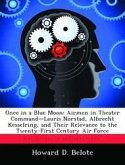The purpose of this monograph is to examine what institutional challenges exist within the Air Force that prevent the service from producing leaders competitive for Geographic Combatant Command positions. The author proposes the Joint Force Air Component Commander (JFACC) position remains the ultimate focal point of warfighter development. Furthermore, institutional priorities early in Airmen's career fail to put the appropriate emphasis on joint staff assignments. A brief examination of service culture shows the importance of technology, occupying the primary emphasis in its command and control doctrine. Early airpower theorists believed technologically advanced bombers would win wars independently. Experiences in World War II demonstrated that belief was not accurate. The Air Force shifted its emphasis to centralizing control of airpower to achieve the greatest efficiency and effects at the theater level. The centralized control debate reoccurred in every major war through the Twentieth Century; the Air Force remains a staunch believer in the tenet. Based on validation from Operation Desert Storm, the service sees the JFACC as the best answer to the debate. The current wing commanders'; careers show a tight timeline due to service requirements. Currently, a heavy emphasis on command exists with multiple tours at the O-6 level. Meanwhile, experience in key warfighting joint and service staff assignments is limited. If the Air Force seeks to produce joint warfighting leaders, and it should, it must create space earlier in Airman's career for joint opportunities.
Hinweis: Dieser Artikel kann nur an eine deutsche Lieferadresse ausgeliefert werden.
Hinweis: Dieser Artikel kann nur an eine deutsche Lieferadresse ausgeliefert werden.








